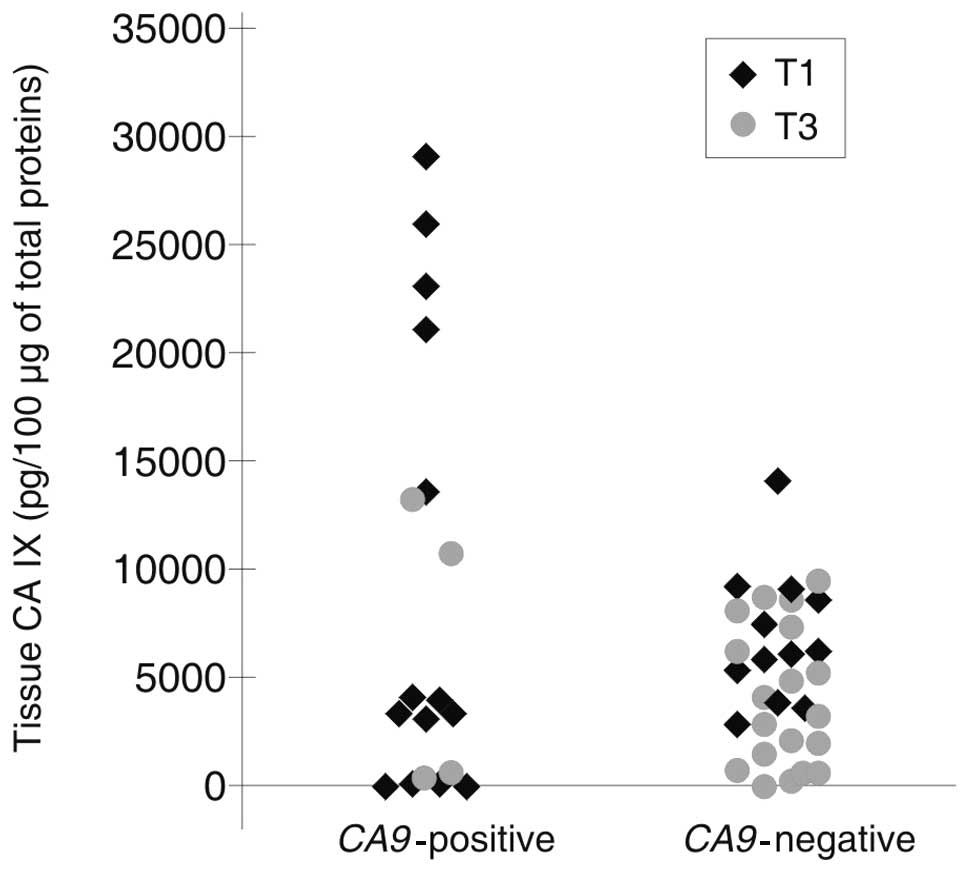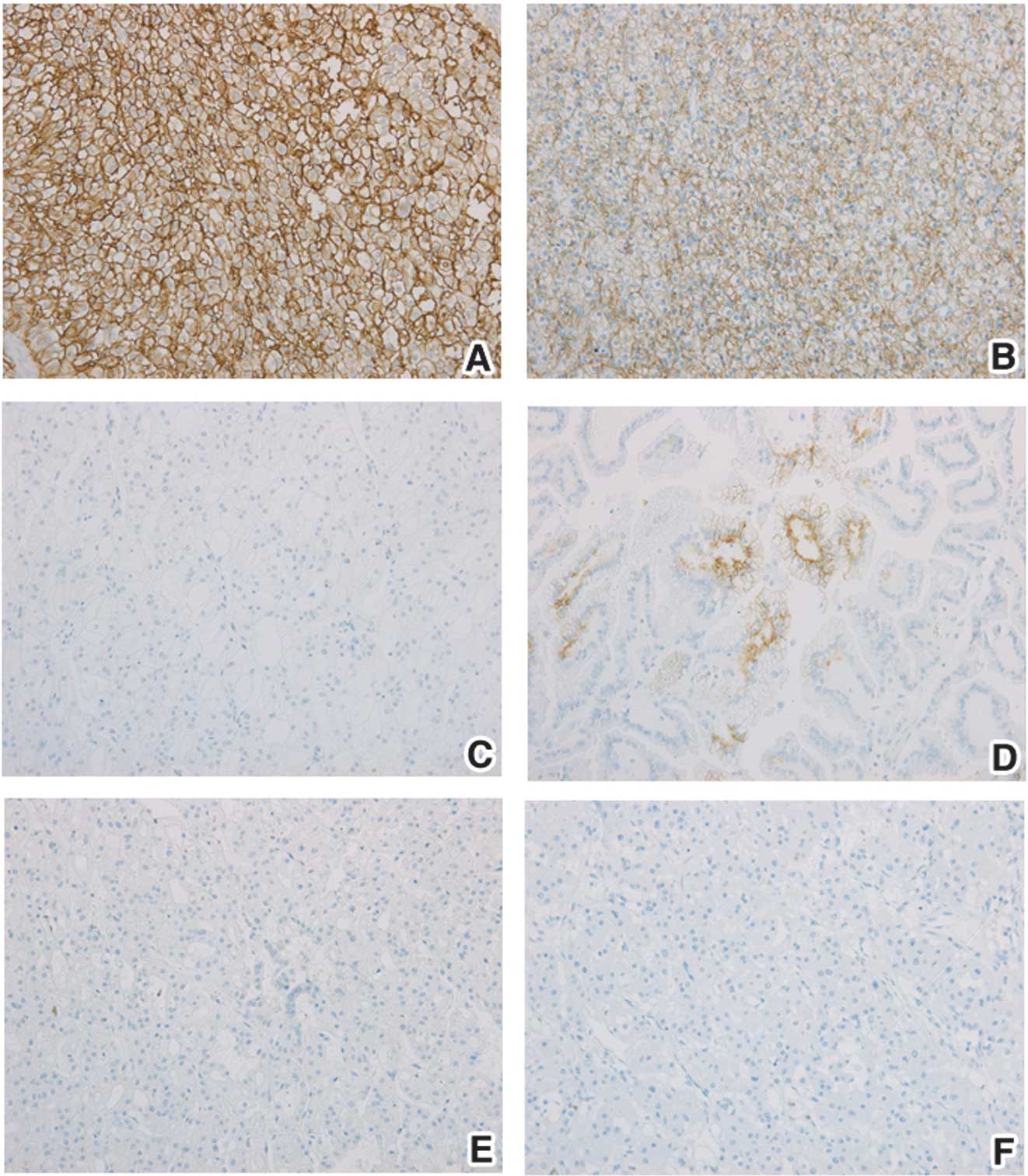|
1
|
Jemal A, Siegel R, Xu J and Ward E: Cancer
statistics, 2010. CA Cancer J Clin. 60:277–300. 2010. View Article : Google Scholar
|
|
2
|
Gnarra JR, Tory K, Weng Y, et al:
Mutations of the VHL tumour suppressor gene in renal carcinoma. Nat
Genet. 7:85–90. 1994. View Article : Google Scholar : PubMed/NCBI
|
|
3
|
Wykoff CC, Beasley NJ, Watson PH, et al:
Hypoxia-inducible expression of tumor-associated carbonic
anhydrases. Cancer Res. 60:7075–7083. 2000.PubMed/NCBI
|
|
4
|
Svastova E, Hulikova A, Rafajova M, et al:
Hypoxia activates the capacity of tumor-associated carbonic
anhydrase IX to acidify extracellular pH. FEBS Lett. 577:439–445.
2004. View Article : Google Scholar : PubMed/NCBI
|
|
5
|
Bui MH, Seligson D, Han KR, et al:
Carbonic anhydrase IX is an independent predictor of survival in
advanced renal clear cell carcinoma: implications for prognosis and
therapy. Clin Cancer Res. 9:802–811. 2003.PubMed/NCBI
|
|
6
|
Pastorekova S, Zavadova Z, Kostal M,
Babusikova O and Zavada J: A novel quasi-viral agent, MaTu, is a
two-component system. Virology. 187:620–626. 1992. View Article : Google Scholar : PubMed/NCBI
|
|
7
|
Zat’ovicova M, Tarabkova K, Svastova E, et
al: Monoclonal antibodies generated in carbonic anhydrase
IX-deficient mice recognize different domains of tumour-associated
hypoxia-induced carbonic anhydrase IX. J Immunol Methods.
282:117–134. 2003.
|
|
8
|
Atkins M, Regan M, McDermott D, et al:
Carbonic anhydrase IX expression predicts outcome of interleukin 2
therapy for renal cancer. Clin Cancer Res. 11:3714–3721. 2005.
View Article : Google Scholar : PubMed/NCBI
|
|
9
|
Bluemke K, Bilkenroth U, Meye A, et al:
Detection of circulating tumor cells in peripheral blood of
patients with renal cell carcinoma correlates with prognosis.
Cancer Epidemiol Biomarkers Prev. 18:2190–2194. 2009. View Article : Google Scholar : PubMed/NCBI
|
|
10
|
McKiernan JM, Buttyan R, Bander NH, et al:
The detection of renal carcinoma cells in the peripheral blood with
an enhanced reverse transcriptase-polymerase chain reaction assay
for MN/CA9. Cancer. 86:492–497. 1999. View Article : Google Scholar
|
|
11
|
de la Taille A, Katz A, Cao Y, et al:
Blood-based RT-PCR assays of MN/CA9 or PSMA: clinical application
in renal cancer patients. Urology. 56:393–398. 2000.PubMed/NCBI
|
|
12
|
Gilbert SM, Whitson JM, Mansukhani M, et
al: Detection of carbonic anhydrase-9 gene expression in peripheral
blood cells predicts risk of disease recurrence in patients with
renal cortical tumors. Urology. 67:942–945. 2006. View Article : Google Scholar : PubMed/NCBI
|
|
13
|
Ohlmann CH, Ozgur E, Schrader AJ, et al:
Detection of circulating tumor cells in patients with renal cell
carcinoma by reverse transcriptase polymerase chain reaction for
G250/MNCA-9: results of a prospective trial. Urol Oncol.
24:287–293. 2006. View Article : Google Scholar
|
|
14
|
Opavsky R, Pastorekova S, Zelnik V, et al:
Human MN/CA9 gene, a novel member of the carbonic anhydrase family:
structure and exon to protein domain relationships. Genomics.
33:480–487. 1996. View Article : Google Scholar : PubMed/NCBI
|
|
15
|
Barathova M, Takacova M, Holotnakova T, et
al: Alternative splicing variant of the hypoxia marker carbonic
anhydrase IX expressed independently of hypoxia and tumour
phenotype. Br J Cancer. 98:129–136. 2008. View Article : Google Scholar
|
|
16
|
Malentacchi F, Simi L, Nannelli C, et al:
Alternative splicing variants of carbonic anhydrase IX in human
non-small cell lung cancer. Lung Cancer. 64:271–276. 2009.
View Article : Google Scholar : PubMed/NCBI
|
|
17
|
Malentacchi F, Vinci S, Melina AD, et al:
Splicing variants of carbonic anhydrase IX in bladder cancer and
urine sediments. Urol Oncol. Sep 25–2010.(Epub ahead of print).
|
|
18
|
Zavada J, Zavadova Z, Zat’ovicova M, Hyrsl
L and Kawaciuk I: Soluble form of carbonic anhydrase IX (CA IX) in
the serum and urine of renal carcinoma patients. Br J Cancer.
89:1067–1071. 2003. View Article : Google Scholar : PubMed/NCBI
|
|
19
|
Li G, Feng G, Gentil-Perret A, Genin C and
Tostain J: Serum carbonic anhydrase 9 level is associated with
postoperative recurrence of conventional renal cell cancer. J Urol.
180:510–513; discussion. 513–514. 2008. View Article : Google Scholar : PubMed/NCBI
|
|
20
|
Zhou GX, Ireland J, Rayman P, Finke J and
Zhou M: Quantification of carbonic anhydrase IX expression in serum
and tissue of renal cell carcinoma patients using enzyme-linked
immunosorbent assay: prognostic and diagnostic potentials. Urology.
75:257–261. 2010. View Article : Google Scholar
|
|
21
|
Papworth K, Sandlund J, Grankvist K,
Ljungberg B and Rasmuson T: Soluble carbonic anhydrase IX is not an
independent prognostic factor in human renal cell carcinoma.
Anticancer Res. 30:2953–2957. 2010.PubMed/NCBI
|
|
22
|
Pena C, Lathia C, Shan M, Escudier B and
Bukowski RM: Biomarkers predicting outcome in patients with
advanced renal cell carcinoma: results from sorafenib phase III
Treatment Approaches in Renal Cancer Global Evaluation Trial. Clin
Cancer Res. 16:4853–4863. 2010. View Article : Google Scholar
|
|
23
|
Wind TC, Messenger MP, Thompson D, Selby
PJ and Banks RE: Measuring carbonic anhydrase IX as a hypoxia
biomarker: differences in concentrations in serum and plasma using
a commercial enzyme-linked immunosorbent assay due to influences of
metal ions. Ann Clin Biochem. 48:112–120. 2011. View Article : Google Scholar
|
|
24
|
Zatovicova M, Sedlakova O, Svastova E, et
al: Ectodomain shedding of the hypoxia-induced carbonic anhydrase
IX is a metalloprotease-dependent process regulated by TACE/ADAM17.
Br J Cancer. 93:1267–1276. 2005. View Article : Google Scholar : PubMed/NCBI
|
|
25
|
Liao SY, Aurelio ON, Jan K, Zavada J and
Stanbridge EJ: Identification of the MN/CA9 protein as a reliable
diagnostic biomarker of clear cell carcinoma of the kidney. Cancer
Res. 57:2827–2831. 1997.PubMed/NCBI
|
|
26
|
Sandlund J, Oosterwijk E, Grankvist K,
Oosterwijk-Wakka J, Ljungberg B and Rasmuson T: Prognostic impact
of carbonic anhydrase IX expression in human renal cell carcinoma.
BJU Int. 100:556–560. 2007. View Article : Google Scholar : PubMed/NCBI
|
|
27
|
Patard JJ, Fergelot P, Karakiewicz PI, et
al: Low CAIX expression and absence of VHL gene mutation are
associated with tumor aggressiveness and poor survival of clear
cell renal cell carcinoma. Int J Cancer. 123:395–400. 2008.
View Article : Google Scholar : PubMed/NCBI
|
|
28
|
Wiesener MS, Munchenhagen PM, Berger I, et
al: Constitutive activation of hypoxia-inducible genes related to
overexpression of hypoxia-inducible factor-1alpha in clear cell
renal carcinomas. Cancer Res. 61:5215–5222. 2001.PubMed/NCBI
|












